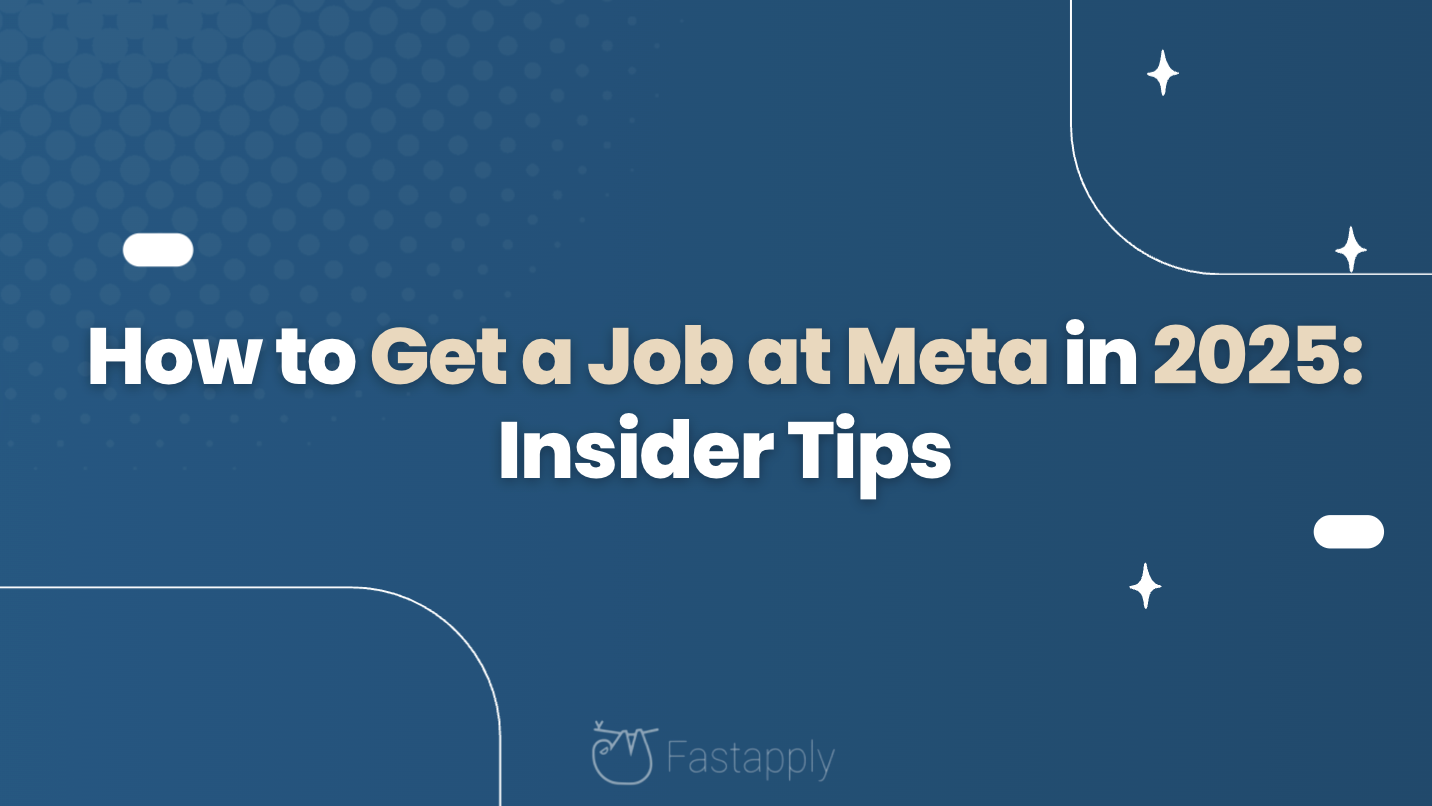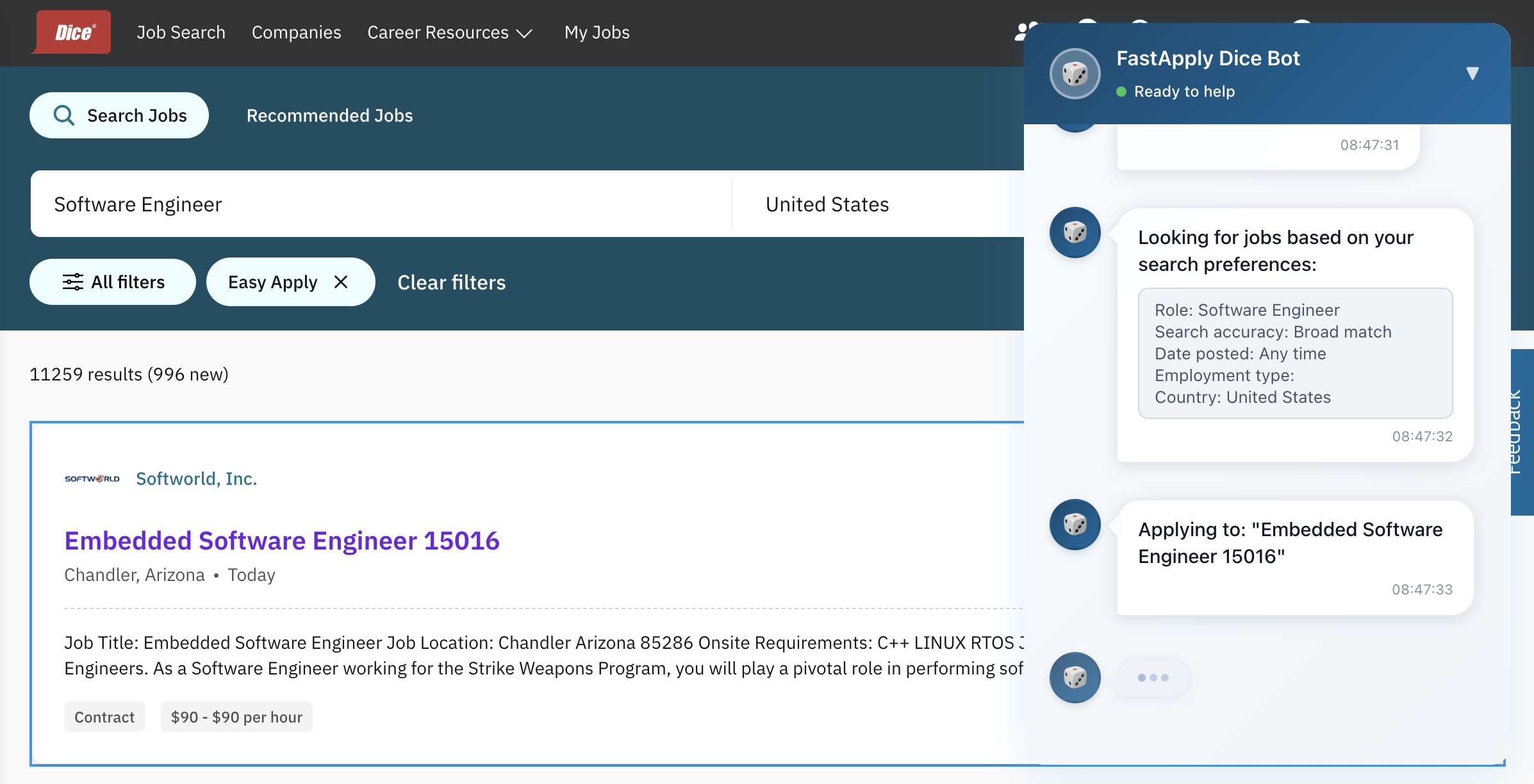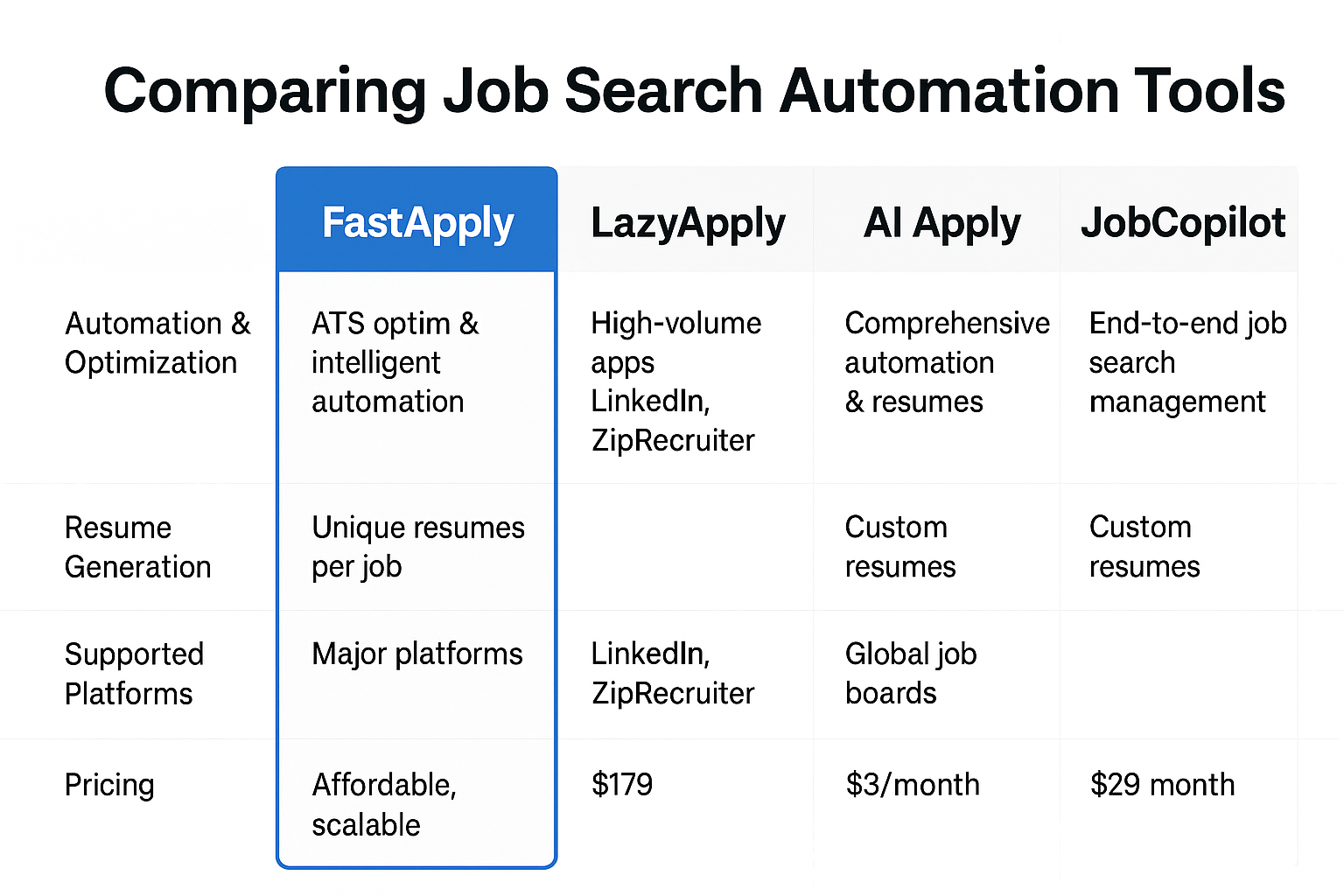How to Get a Job at Meta in 2025: Insider Tips

Meta is one of the most desired employers in the tech industry. It offers the chance to create products that touch billions of users worldwide. With competitive pay and the opportunity to work with the latest technology, it is no wonder that getting a job at Meta is so tough. This guide will help you understand what the company is looking for and how to utilize tools like FastApply to make your job search easier.
Understanding Meta’s Competitive Hiring Landscape
The reality of applying to Meta is sobering. Acceptance rates remain in the low single digits, even for candidates with strong backgrounds and credentials. The competition is fierce. Meta’s hiring standards are very high, and job postings often require more experience than the title might suggest. A position listed as mid-level might actually expect candidates to bring significant prior experience that would be considered senior-level elsewhere. This pattern extends across all departments, including engineering, product management, design, marketing, and research. Before investing significant time in your application, carefully review the actual requirements and assess whether your background truly aligns with what Meta is seeking.

The ATS Challenge
Meta’s Applicant Tracking System presents one of the first major hurdles. The system depends on keyword matching. This means your resume must closely match the language used in job descriptions. Using “Python” when the listing specifies “Python” is essential. Abbreviations or informal terms might lead to your application being filtered out before a human reviewer sees it. Standard job titles, specific technology names, and measurable achievements are essential for passing this initial screening.
What Meta Values in Candidates
Technical skills and years of experience form just part of what Meta evaluates. The company places significant emphasis on several key qualities:
- Collaboration and Cross-Functional Impact: Meta seeks evidence that you work effectively across teams and contribute to collective success, not just individual achievements.
- Innovation and Initiative: Examples of proposing new projects, solving problems creatively, or driving change demonstrate the forward-thinking mindset Meta seeks.
- Adaptability and Learning Agility: The ability to navigate ambiguity, pivot quickly, and grow from challenges matters immensely in Meta’s fast-moving environment.
- Alignment with Core Values: Meta’s principles—being bold, focusing on impact, moving fast, maintaining openness, and building social value—should naturally emerge through the stories you tell about your work. The most successful candidates don’t just list these qualities; they demonstrate them through specific examples with quantifiable outcomes.
The Power of Referrals
While you can apply directly through Meta’s careers portal, employee referrals significantly boost your chances of getting through the initial screening. Referrals ensure that a human reviewer assesses your application and can provide context that an ATS might overlook.
Building these connections takes real networking. Reach out to Meta employees via LinkedIn or alum networks, but do this carefully. Research their team and the company’s current priorities before you reach out. Make your contact a genuine effort to learn, not just a quick request for a referral.
Timing Your Applications
For internships and new graduate positions, timing is critical. These roles often open nearly a year in advance and fill rapidly. Set up job alerts and apply as soon as the positions become available. For experienced roles, consistency matters—regularly check for new postings and be prepared to act quickly.
Resume Optimization for Meta’s ATS
Your resume needs to speak the ATS’s language while remaining compelling for human reviewers:
- Mirror the job description keywords exactly—use the precise technical terms, tools, and frameworks mentioned
- Quantify everything possible: “Increased efficiency by 40%” or “Led a team that delivered features to 2 million users”
- Use standard formatting with clear sections and conventional job titles
- Keep it concise and scannable—recruiters spend mere seconds on initial reviews
- Include portfolio links prominently for design, product, and marketing roles For technical roles, focus on system design, architectural choices, and technical knowledge. For design positions, ensure your portfolio includes detailed case studies with clear explanations for your design decisions. Product managers should emphasize making decisions based on data and leading teams from different areas.
Automating Your Job Search with FastApply
Manually searching for jobs and customizing applications for each role is time-consuming and often inefficient, especially when targeting a company like Meta, where timing and precision matter enormously. This is where FastApply transforms the job search process.
Why Job Search Automation Matters
Modern job hunting, particularly for competitive positions at companies like Meta, demands:
- Speed: Roles open and close quickly; delays mean missed opportunities
- Customization: Each application needs to be tailored to match specific job requirements
- Scale: Applying to multiple relevant positions increases your odds
- Consistency: Tracking applications and following up appropriately Doing this manually for dozens or hundreds of applications becomes unsustainable. FastApply addresses these challenges by automating the application workflow while maintaining the personalization that ATS systems and recruiters expect.
How FastApply Enhances Your Meta Job Search
FastApply uses AI to automate your job search process intelligently:
- Automated Application Submission: FastApply applies to relevant positions on your behalf across multiple job boards and ATS platforms
- Custom Resume Generation: For each position, the platform analyzes the job description and generates an optimized resume that matches the specific requirements and keywords
- Multi-Platform Support: Apply across LinkedIn, Greenhouse, Lever, and other major platforms where Meta posts positions
- Application Tracking: Monitor all your applications through a centralized dashboard Form Intelligence: The system handles complex application forms, recognizing required fields and ensuring complete submissions The key advantage isn’t just speed—it’s the combination of automation with intelligent customization. Each FastApply application submitted is tailored to the specific role, dramatically improving your chances of passing ATS screening while saving you hours of manual work.

Comparing Job Search Automation Tool
While several AI-powered job search platforms exist, they vary significantly in capability and effectiveness. Here’s how the leading options compare:
- FastApply: Best for intelligent automation with strong ATS optimization. Supports major job platforms and generates unique resumes for each application. Pricing is affordable and scales with usage.
- LazyApply: Focuses on high-volume, one-click applications across LinkedIn and ZipRecruiter, with limited customization capabilities. The annual subscription costs approximately $179.
- AI Apply: Offers comprehensive automation across global job boards with advanced resume generation for each application. Priced around $25 per month.
- JobCopilot: Provides end-to-end job search management with multi-board support and application tracking, with a monthly subscription of around $29. For candidates targeting Meta specifically, the priority should be tools that emphasize quality and customization over pure volume. FastApply’s approach of generating tailored resumes and intelligently parsing job requirements aligns well with Meta’s stringent ATS and high hiring standards.

Navigating Meta’s Interview Process
Once you’ve cleared the initial screening, Meta’s interview process is comprehensive and demanding, typically spanning four to eight weeks:
Recruiter Screen
Your first conversation will be a 30-minute phone call with a recruiter, who will cover your background, motivations, and basic qualifications. Prepare thoughtful answers about why you’re interested in Meta specifically and how your values align with the company’s mission. Research Meta’s recent product launches and strategic initiatives.
Technical and Role-Specific Assessments
Engineers face coding challenges and system design problems. Expect algorithmic questions similar to those on LeetCode, as well as discussions about scalability, architecture, and trade-offs in system design. Product Managers work through product sense cases and analytical exercises. You may be asked to design a product to meet a specific user need or interpret product metrics to make informed recommendations. Designers present their portfolios and participate in design critiques, often focusing on Meta’s own products, such as Instagram or WhatsApp. You may be assigned a design exercise to complete within a specified timeframe. Data Scientists and Researchers demonstrate technical skills in SQL, experiment design, and statistical analysis, along with the ability to communicate complex findings clearly.
Onsite Interview Loop
The main evaluation phase typically consists of three to five interviews (often conducted virtually) with team members, hiring managers, and cross-functional partners. These sessions blend technical assessments with behavioral questions designed to evaluate how you work, learn, and collaborate.
Final Evaluation
For senior or strategic positions, a final panel may review your overall candidacy, focusing on leadership, domain expertise, and strategic thinking.
Preparation Strategies That Work
Use the STAR Method: Structure behavioral answers with Situation, Task, Action, and Result, back up claims with specific metrics and outcomes.
- Practice Extensively: Engineers should work through coding problems daily on platforms like LeetCode. Product managers benefit from case practice on platforms like Exponent. Designers should refine portfolio presentations and practice design critiques.
- Prepare Real Examples: Have detailed stories ready that demonstrate collaboration, innovation, handling ambiguity, and driving impact. Generic answers rarely succeed.
- Research Meta’s Products: Understand the products you’d be working on. Have opinions about their strengths, weaknesses, and opportunities.
- Mock Interviews: Practice with peers or mentors who can give honest feedback. Multiple rounds of practice significantly improve performance.
Meta Compensation: What to Expect
Meta consistently offers compensation at the top of the market, often exceeding other major tech companies. Total compensation packages consist of three primary components:
- Base Salary: Your fixed annual salary, paid bi-monthly
- Annual Bonus: Typically 10-15% of base salary for most roles, with potential for overachievement
- Equity (RSUs): Restricted Stock Units often represent the most significant portion of compensation, especially for mid-level and senior roles. Meta also offers stock refreshers for strong performers.
Compensation by Role and Level (2025 Estimates)
- Software Engineers:
- Entry-level (early career): $170K-$200K total compensation
- Mid-level (5-8 years): $480K-$550K total compensation
- Senior (10+ years): $800K-$1M+ total compensation
- Product Managers:
- Entry-level: $160K-$180K total compensation
- Mid-level: $400K-$480K total compensation
- Senior: $600K-$700K total compensation
- Designers:
- Entry-level: $130K-$160K total compensation
- Mid-level: $300K-$370K total compensation
- Senior: $450K-$550K total compensation
- Marketing Professionals:
- Entry-level: $150K-$180K total compensation
- Mid-level: $250K-$300K total compensation
- Senior: $380K-$450K total compensation
- Data Scientists and Researchers:
- Entry-level: $150K-$180K total compensation
- Mid-level: $400K-$480K total compensation
- Senior: $750K-$900K total compensation These figures represent total annual compensation, including salary, bonus, and the annualized value of stock options. Location significantly impacts compensation. San Francisco and New York typically offer the highest packages, while London and remote roles may be 5-10% lower than the rates in major tech hubs.
Negotiation Tactics
Meta anticipates that candidates will negotiate, and there is typically some room for negotiation in offers. To prepare:
- Do your homework: Use resources like Levels.fyi and Glassdoor to understand market rates for your position and level.
- Be specific: Use specific data points when making your case.
- Think total compensation: Don’t focus solely on base salary- equity, for example, is often the most significant piece of compensation.
- Ask about anything: Signing bonus, refreshers, relocation assistance, annual stock equity, etc.
- Collect competing offers: Having multiple offers gives you a significant advantage in negotiating.
Post-Application Strategies and Long-Term Success
Record every application in detail, including the date you submitted it, how you heard of the role, follow-up dates, and outcomes. Keeping this record organized enables you to time your follow-ups effectively and identify patterns in what is working. If you received a rejection notice, can you reapply for the same position (Meta typically advises waiting six months), or is it okay to apply for other positions sooner?
Continuous Networking
Don’t regard networking as a one-off job you do before applying. Think about who you stay connected with professionally, what Meta employees are posting on LinkedIn, and if you can schedule informational interviews to get a sense of the current team’s difficulties and priorities. Authentic connections sometimes yield opportunities months or even years later.
Common Mistakes to Avoid
- Basic Applications: Generic resumes do not pass Meta’s ATS screening. Every application will need to be tailored to meet specific needs.
- Keyword Misalignment: Refusing to use specific terms and exact technologies as recommended in the job description isn’t worth your time.
- Not Enough Practice for the Interview: When you walk into an interview without sufficient practice, it often yields little to no success. Interviews at Meta are rigorous and require thorough preparation.
- Early Disappointment: Some employees who are now successful at Meta experienced multiple rejections prior to receiving an offer—it’s essential to persevere and show up again.
Career Growth Within Meta
Once you’re in Meta, you will find a culture of continual learning and adaptability. Successful performance involves much more than what you’ve done in the past; you’ll need to consistently exhibit continued impact, adaptability, and a high level of effort. Those same organized and data-driven approaches that helped you get the job you currently have will help you succeed in navigating advancement opportunities internally.
Conclusion
Acquiring a role at Meta involves careful planning, diligent work, and often multiple efforts. It requires: Thoughtful applications to each role, Creative automation methods through tools like FastApply to ensure you’re maximizing opportunities without sacrificing quality
- Thorough interview preparation through structured practice and feedback
- Consistent attempts, regardless of rejection For candidates willing to put in this effort, there are significant opportunities, both in terms of career advancement and compensation. FastApply and similar tools help level the playing field by ensuring your applications meet Meta’s standards and allowing you to concentrate your efforts on networking for potential job opportunities and preparing for interviews.
Securing a job at Meta is a challenging process, but it is possible for candidates who come prepared and develop a strategic execution plan.
Frequently Asked Questions
How difficult is it really to get hired at Meta?
Extremely competitive. Acceptance rates remain in the low single digits even for experienced candidates. Success requires tailored applications, strong referrals, and extensive preparation.
What qualities does Meta prioritize in candidates?
Beyond technical skills, Meta values collaboration, innovation, adaptability, and alignment with company values: being bold, focusing on impact, moving fast, maintaining openness, and building social value.
How should I optimize my resume for Meta?
Use exact keywords from job descriptions, quantify all achievements with specific metrics, maintain clean formatting with standard job titles, and include portfolio links for creative and product roles.
How can FastApply improve my chances of landing a Meta role?
FastApply automates application submission across major job platforms, generates customized, ATS-optimized resumes for each position, and provides application tracking—saving time while improving quality and consistency.
What compensation should I expect at Meta in 2025?
Meta offers top-of-market pay. Entry-level engineers typically earn a total compensation of $170,000-$200,000, while senior roles can exceed $800,000 annually, including salary, bonus, and stock options.
#Meta
#Job Hunting
#Career
#AI/ML Engineers

FastApply Team
Career Experts
